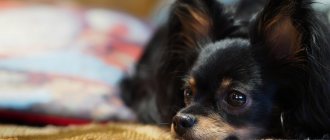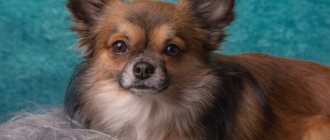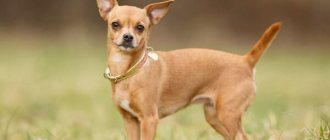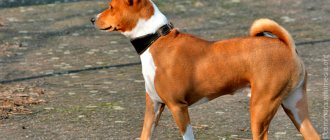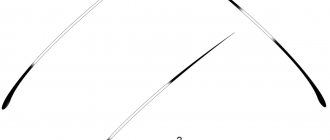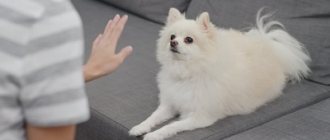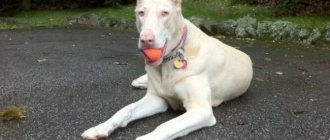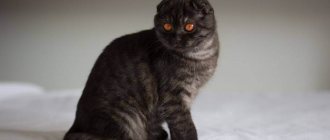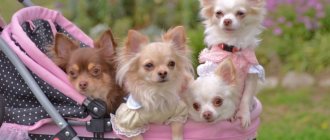1873
Author of the article
Ekaterina Andreeva
Reading time: 8 minutes
A A
When you try to find Chihuahua colors from photos, the list is truly surprising. It’s easy to get lost in all the diversity that opens up to your eyes, which is what some breeders take advantage of, not failing to indicate in the advertisement that their charges are truly unique. I suggest you look into this issue and somewhat systematize the abundance of information in your head.
Prohibited color
I think it’s better to start right away with the colors, which are prohibited by dog handlers. An ordinary Chihuahua lover who does not understand the breed, when viewing a photo, may be touched by cute dogs with a color reminiscent of marble. I agree, a small dog with such spots and stains actually looks cute.
This merle color is achieved due to the uneven coloring of the hairs. It doesn’t matter what kind of stains a smooth-haired or long-haired animal has - they can be black or brown . The main thing is that part of the pile differs in palette. For the first time, breeders had to deal with such a rare dog in the 90s in America.
IMPORTANT: I do not recommend focusing on those breeds of dogs that are also marbled. This list includes the dachshund, collie, and Australian shepherd.
Chihuahuas are a completely different story. The puppy may well be deaf, blind, or have other eye problems. In especially severe cases, the animal is born without organs of vision and hearing. Sometimes it can be sterile - I think under the circumstances it's clear why that's a good thing.
Often a dog of this color dies at birth. Especially at risk are the so-called “double merles” - that is, animals in which both parents were defective. Such animals sometimes face problems related to bones and heart. In addition to those I listed above.
Conclusion
Representatives of this breed are ideal for people with any temperament and hobbies. And following the basic rules will help to achieve the desired coat color and will protect against the occurrence of puppies with the M gene in the family.
When planning to have an offspring, you need to first think about the baby’s health. If the four-legged parents did not have pathologies, then there is every chance of counting on a strong dog. The Chihuahua will become a devoted companion, a reliable nanny, and a full-fledged member of the family.
The Chihuahua knows how to adapt to the owner’s character and senses his mood.
Keeping a miniature friend is easy. The main thing is to strictly adhere to the diet, which should be balanced, and monitor the dog’s hygiene.
Short-haired pets cause less worries. They do not require regular brushing.
White and black colors
A dark and light palette of this kind is usually considered a classic, but in the case of a Chihuahua, things are a little different:
- The black dog is, oddly enough, rare. I mean, in its purest form. For, as a rule, there is a small white spot in the area of the chest and paws.
- White – this color in mono version is also quite rare.
- Spotted – but this kind of animal can be found more often. This is, for example, a light dog and black spots included. They are contrasting, large, located on the head and torso. Or it is a dark representative with small white spots, as I wrote about above.
Categorical culling
This category includes dogs with physiological abnormalities that do not meet the standards of the Chihuahua breed. Most of the deficiencies do not affect the health of the dogs, but simply do not allow the dogs to become participants in exhibitions.
This is interesting: What determines the cost of a sneeze
Marriage is considered:
- poor functioning of the organs of hearing and smell;
- sparse hair, receding hairline;
- neurological disorders;
- hydrocephalus;
- lameness, swelling of the paws.
Diseases can be congenital and appear in pets in adulthood.
Breed diseases
Chihuahuas (black, fawn, brindle and any others) are distinguished by excellent health. They have a very strong immune system, so they rarely get sick. But, like any other creature, these little ones are prone to some breed ailments. They often have problems with vision and the cardiovascular system.
These miniature creatures are often diagnosed with dislocations, as well as dysplasia of the hip or elbow joints. In addition, chocolate, Isabella, or black Chihuahua puppies suffer from hypoglycemia.
Officially accepted Chihuahua breed standards
The black Chihuahua, except for the shade, is no different from representatives of the breed of other colors. There is an officially recognized breed standard:
- The skull is round, there is no fontanel, but according to the standard, a slight depression is allowed.
- The nose is upturned and of short length. The lobe is traditionally black, but another shade is acceptable.
- The muzzle is short, tapering towards the nose.
- The eyes are large and round.
- The ears are triangular in shape and wide open.
- Straight or scissor bite.
- The neck is curved at the top. The short length is a disadvantage.
- The chest is wide and deep, the ribs are smoothly rounded.
- The tail is of medium length, curved towards the loin and set high.
- The front legs are straight, the hind legs are well muscled.
Important! The length of an animal's body is always greater than its height.
Based on coat type, the following types of Chihuahuas are recognized:
- Smooth-haired. The coat is short, smooth, and may or may not have an undercoat. The white smooth-haired Chihuahua is often found.
- Shorthair. Is an unacceptable coat type.
- Long-haired. The coat is thin, slightly wavy or straight, and can sometimes be fluffy. Near the ears it forms waves reminiscent of fringe.
The breed standard is officially approved, and individuals must comply with it
Key points in training
Training a breed can be a challenging task, so education is the first issue. They need to be taught order and family hierarchy. A small lap dog should not be allowed to sit on a person’s neck. She must remember several rules: eating only after the family gets up from the table (begging is suppressed), entering the house after household members, sleeping and playing on the owner’s furniture is prohibited.
After the puppy remembers the name and gets used to his schedule, you can try to teach him basic commands that will help control the pet: sit, next to me, not allowed, quiet.
Contacting cynological services and clubs will make the owner’s work easier. Plus, pets are better trained in a group. Chihuahuas are good at agility, so a course with obstacles will be a good workout and a way to concentrate.
Read about how to properly train a dog in the article: “Training a puppy: effective methods from dog handlers, learning commands at home.”
Dossier
Height of an adult dog: 15-23 cm. Weight: up to 3 kg. Characteristic color: varied, from white to black, brown. Coat length: longhaired. Life expectancy: up to 20 years. Advantages of the breed: high intelligence, agreeableness, good health. Difficulties of the breed: talkative, brave beyond its size. Average price: 200-2000 dollars. Classification: small, decorative, companion.
How to choose a future pet
Choosing a puppy begins with selecting a kennel with a good reputation, where the purchase should take place. It is best to read reviews of the shelter and talk to people who have used it, as this will give you a definite impression.
Useful tips for choosing Chihuahua puppies:
- When starting to choose, you should not give in to the temptation and take the puppy that you like best based on its color and eye color. Initially, you need to pay attention to his state of health and purebred. There is no need to choose pets with discharge from the eyes, an unpleasant odor from the mouth, traces of alopecia and unkempt fur.
- It is also better to avoid overly melancholic and cowardly animals, especially if it is an adult dog. It is best to give preference to the pet that was the first to go to the meeting.
- Buying a mixed breed in order to save money is also not the best idea. The overwhelming percentage of such dogs have congenital pathologies, and they are also characterized by unstable psyche.
- When choosing, the gender of the pet also plays an important role. Chihuahua girls are more capricious, while boys, on the contrary, are obedient. Girls, unlike boys, mark their territory less, which is an undeniable advantage.
- You should also pay attention to the weight of your pet. A puppy at the age of 3 months should not weigh less than 0.5 kg and more than 2.7 kg.
Important! Having decided on a specific pet, you should check whether the breeder has documents for it. Documents on vaccinations performed are also subject to verification.
It is important to be responsible when choosing a puppy so as not to purchase an unhealthy pet.
The black Chihuahua is a unique pet that has not only attractive external features, but also a wonderful character, of course, subject to proper training. You just need to choose a dog that is suitable in character, who will eventually become a reliable friend.
Does a puppy's color change as it ages?
Blue Chihuahua puppies can turn blue-fawn, almost black and even red.
Dogs that have blue noses, paw pads and eyelids will either remain bluish-gray or change to blue-fawn.
Puppies with black pigmentation on the nose, paws and eyelids often fade to a reddish color.
What are the varieties?
Smooth-haired
The smooth-haired variety of Chihuahua has a smooth, silky coat that lies close to the body. The presence of undercoat and its thickness do not matter.
Shorthair
The short-haired variety of the breed is transitional between smooth-haired and long-haired. The hair of these dogs is slightly longer than that of smooth-haired white Chihuahuas, but shorter than that of long-haired ones.
NOTE!
Shorthaired Chihuahuas are considered a breeding stock and are out of breed.
Longhair
The white coat of long-haired Chihuahuas reaches a considerable length; it forms feathers on the neck, paws and along the edges of the ears, which looks very elegant. The hairs themselves are thin and soft, but they should not be excessively long and flutter or cascade.
Mini
The weight of these dogs does not exceed 1.5 kg, but is usually less. The lower weight limit allowed for white mini Chihuahuas is 1 kg.
Micro
Micro Chihuahuas are the smallest of all representatives of this breed. The weight of these white dogs is 0.5-1 kg.
Cobby
White Chihuahuas of this type have a stocky build. They have a relatively large head with a rounded forehead and a rather short muzzle, expressive bulging eyes and widely spaced, not too large ears. Their body is muscular, their movements are energetic and quite strong.
Dir
White Chihuahuas of the Deer type look like porcelain figurines: they are slender, elegant and graceful, and in their structure they resemble miniature deer. They have slightly elongated heads with a rather long muzzle, and their movements are light and agile.
Rules of care
Caring for smooth-haired and short-haired blue dogs consists of systematic (2-3 times a week) brushing. Long-haired Chihuahuas need to be combed daily.
It is not necessary to wash dogs often, and it is better not to do it at all unless necessary, as blue Chihuahuas can be sensitive to grooming products such as shampoos and conditioners.
You should periodically examine your pet's ears, but clean them only if they are dirty. Eyes also need to be cleaned as they become dirty or sour.
Chihuahuas' claws are trimmed once every two weeks using a guillotine nail clipper.
teeth
are cleaned with the help of special toys or treats that are given to the pet to chew on.
CAREFULLY!
If tartar forms, you should not try to remove it yourself. You need to take your pet to the clinic, where the veterinarian can easily and painlessly rid him of hardened plaque.
Like all other small breeds, blue Chihuahuas need to be covered in rain or cold weather.
Brief history of origin
The Chihuahua is considered an exquisite breed, the virtues of which every owner will appreciate.
In the 15th century BC, the first black individuals, called techichi, were found in Mexico. They were bred by the Toltecs and held the title of sacred animal. In the 17th century AD, Aztec tribes came to Mexico and ousted the Toltecs, but the Techichi did not lose their status. However, this can hardly be called an achievement, because they were often brought as a sacrifice to the gods or, in the event of the death of the owner, they were buried with him in the same grave.
After Mesoamerica was conquered by the Spaniards, the animals were in danger; they began to be destroyed during the destruction of Indian temples. However, several pets were able to escape into the forests, where they lived for centuries. During this time, Techichi, being in the forests, interbred with their relatives, and possibly with other wild animals. At the beginning of the 19th century, when they were caught and domesticated by local residents, they were no longer Techichi, but a completely different breed.
The first mentions of the breed appeared before our era, so it is classified as ancient
Among the pets that were bred, there were those that were black in color. It was they who became the ancestors of all black chixyaxya.
What do boys and girls look like and how do they differ?
Female Chihuahuas are slightly larger than males, which is why they are more successful in shows.
Males have a square shape, while females have a more elongated body, which is associated with their reproductive functions.
Girls also have a more graceful and thin neck.
Dogs also differ in temperament . Females are calmer, balanced and peace-loving, but aggressive in terms of protecting their offspring, and can be angry. Males are hot-tempered, active, the first to get into fights, and less well trained.
